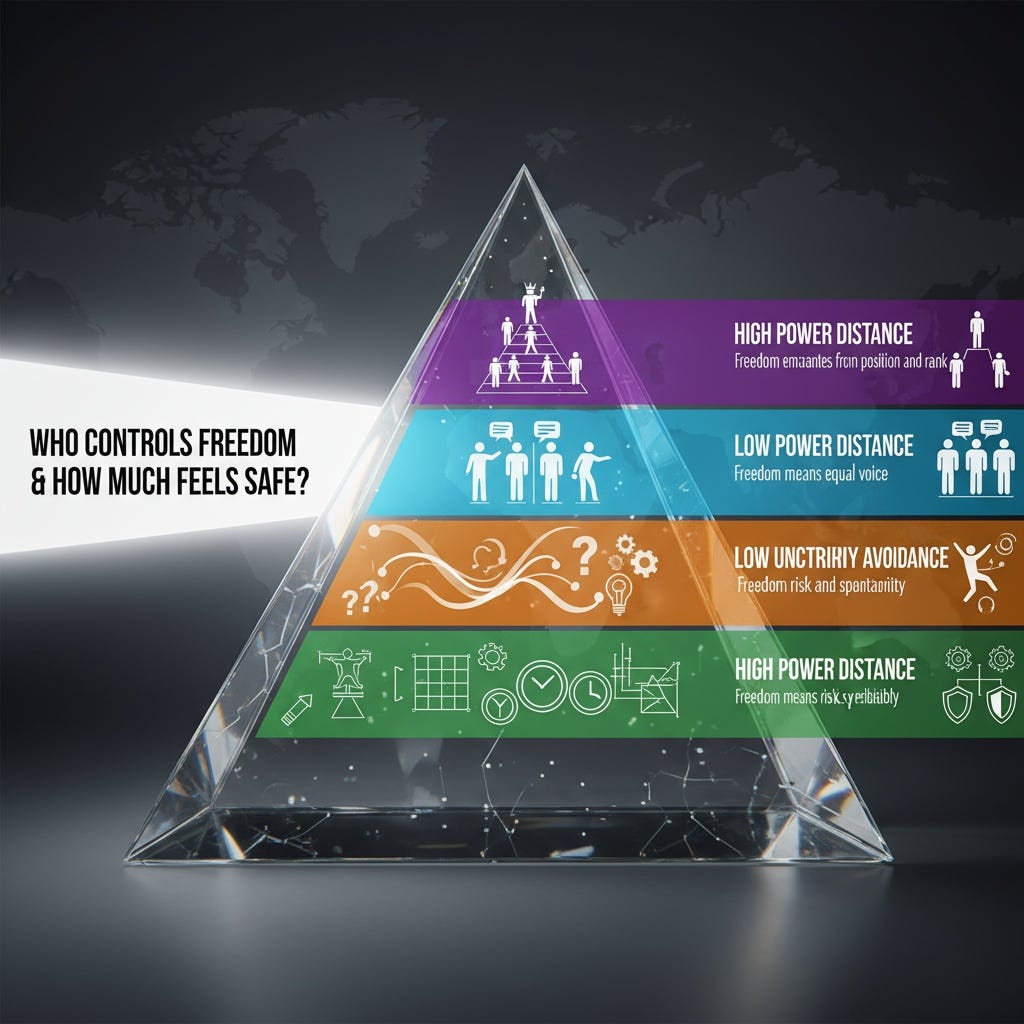Wednesday Edition — Who Decides How Free We Are? Power Distance and Uncertainty Avoidance
Freedom Isn’t What You Think It Is — A Cultural Analysis
Once a society determines who freedom is for (Tuesday’s Edition), it must determine who controls it and how much feels safe.
That’s where Power Distance and Uncertainty Avoidance come in.
Power Distance — Freedom and Hierarchy
Power Distance measures how comfortable people are with hierarchy, how much inequality in authority they consider normal.
In low Power Distance societies, people believe that freedom should be more equal. Ideas are more important than the power, money, or position a person has. This means a manager can be questioned, a politician can be challenged, and a teacher can be corrected by a student. Freedom means equal voice.
In high Power Distance societies, freedom is shaped by hierarchy. A person’s degree of freedom depends on their position. Superiors have more freedom and subordinates have less. Leaders have the freedom to decide and command; others have the freedom to fulfill their roles honorably. In workplaces, speaking freely is a privilege of rank. In families, freedom often means knowing one’s place and maintaining respect. In parts of the Middle East, Southeast Asia, and Africa, people see freedom not in resisting authority but in serving it, the freedom to follow a just leader, uphold religious duty, or preserve ancestral custom. Freedom comes from belonging to a stable order, not breaking from it.
Low Power Distance creates freedom through equality, but also conflict. Meetings take longer because everyone speaks. Protests erupt faster because everyone feels entitled to be heard. High Power Distance creates order and efficiency, but can silence those at the bottom. When freedom flows one way, those below are cautious rather than assertive.
Uncertainty Avoidance — Freedom and Fear
Uncertainty Avoidance measures how much a society tolerates risk and ambiguity. It tells us how safe freedom feels.
In low Uncertainty Avoidance cultures, people accept risk as part of life. Laws are broad. Innovation moves fast. “Trial and error” is an acceptable plan. Freedom means acting before all answers are known. This mindset drives much of the U.S. tech sector, where entrepreneurs build first and regulate later, trusting that mistakes can be fixed along the way.
In high Uncertainty Avoidance cultures, people see safety as freedom. They prefer clear rules, step-by-step procedures, and predictable systems. A teacher expects fixed syllabi; a citizen expects consistent rules. In Germany or Japan, freedom means knowing the train will arrive on time and the law will protect everyone equally. Spontaneity feels like risk, not liberty.
Low Uncertainty Avoidance fuels creativity but invites instability, financial crises, misinformation, and social tension often grow from acting too quickly. High Uncertainty Avoidance builds trust but slows change. Stability becomes comfort, even when it prevents reform.
Hornby’s Archetypes — The Psychology of Control
Hornby’s archetypes reveal how personality types handle power and risk.
The North (Power-Seeker) thrives in low Power Distance settings with the freedom to make decisions and move forward. The Power-Seeker wants to lead, question authority, and make a personal impact. For Uncertainty Avoidance, the Yellow (Creative) flourishes in low-control environments where experimenting is safe and mistakes are accepted.
The Blue (Guardian) belongs in high Power Distance cultures. The Guardian values order and sees freedom in discipline, the freedom to live under clear, stable rules. The Green (Caregiver) prefers predictability; freedom means protection, not adventure.
Together, they explain why some people fight for open systems while others fight to preserve structure. Neither is superior nor inferior, they reflect different answers to the same question: Do we feel free when everything is possible, or when nothing can go wrong?
Freedom in Balance
The freedom we want depends on who gets to decide and how much risk we are willing to live with.
Too little hierarchy, and freedom becomes chaos. Too much hierarchy, and it becomes control.
Too little order, and freedom feels chaos. Too much order, and it feels like control.
Every society draws its own line between authority and anxiety, between freedom that moves and freedom that stays still.
Tomorrow: We’ll explore how Achievement vs. Nurturance divides cultures that define freedom through competition from those that define it through care.
Join us on TikTok and YouTube for more cultural persepctive





